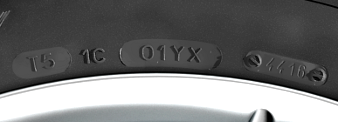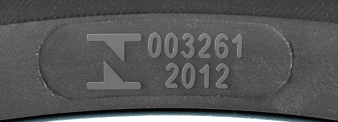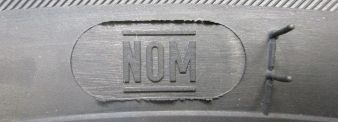How to read a tyre
How to read a tyre sidewall

*Maximum load corresponding to the Load Index (LI)
215: Tyre width in millimetres.
60: Tyre aspect ratio. Ratio of height to section width.
R: Construction = Radial
17: Internal diameter in inches.
100: Load Index. The load index is a code showing the maximum load a tyre can carry at the recommended pressure.*
T: Speed Index. The speed symbol indicates the maximum speed of use under service condition specified by the tyre manufacturer.
LI | lbs | kg |
|---|---|---|
71 | 761 | 345 |
LI | lbs | kg |
|---|---|---|
81 | 1019 | 462 |
LI | lbs | kg |
|---|---|---|
91 | 1356 | 615 |
LI | lbs | kg |
|---|---|---|
101 | 1819 | 825 |
Other marking
Please note that some of these markings are not always used: for example, the 'M+S' marking is solely used for winter tyres.
Brand name: e.g. ORIUM
Tyre Range name: e.g. Ultra High Performance
3PMSF: Sidewall symbol of tyres for use in severe snow conditions. Tyres with the '3 Peaks mountain Snow Flake' marking have been tested and offer snow performances confirmed by regulatory snow tests.

M+S: Tyres with Mud & Snow marking are snow tyres according to European rulings, the snow performance under winter conditions have not been subject to testing.

Tubeless: This indicates that this tyre does not require an inner tube.
Manufacturing information: Tyre Identification Number (TIN) is composed of 8 to 12 digits, please read further for the detailed explanation.
T5: Factory code where the tyre was made (code is 2 or 3 digits)
1C: Tyre size code
01YX: Manufacturer construction code (optional)
4416: Week and year of manufacture

European regulation marking: The 'E' and 'e' markings with the approval numbers marks the compliance with ECE 30 ruling and 2001/43 EC directive and tests associated.
These markings are mandatory for commercialization in EEC countries.

INMETRO: The INMETRO marking with approval number marks the compliance with Brasil’s regulations and associated approval tests.
These markings are mandatory for commercialization in Brazil.

NOM: The NOM marking marks the compliance with Mexican regulation and associated approval tests. This marking is mandatory for commercialization in Mexico.

Uniform Tire Quality Grading (UTQG)
UTQG was established by the National Highway Traffic Safety Administration (NHTSA) to test tyres following government prescribed test methods.Tread wear:
Grades are based on actual road use A grade of 100 would indicate that the tyre tread would last as long as the reference CMT tyre, 200 would indicate the tread would last twice as long, 300 would indicate three times as long, etc.Traction:
Grades are based on the tyre's straight line wet coefficient of traction. The UTQG traction test does not evaluate dry braking, dry cornering, wet cornering, or high speed hydroplaning resistance.
Traction grades are AA, A, B and C (with AA being the highest grade). Any tyre rated under C is considered unacceptable for road travel.Temperature (Resistance):
Grade indicates the tyre’s ability to dissipate heat under controlled indoor test conditions. The temperature grades, from highest to lowest, are A, B and C. Any tyre rated below C is considered unacceptable.

Tyre structure: This branding on the sidewall of a tyre list the materials and number of layers of each material used to reinforce the rubber in the tread and sidewalls.

